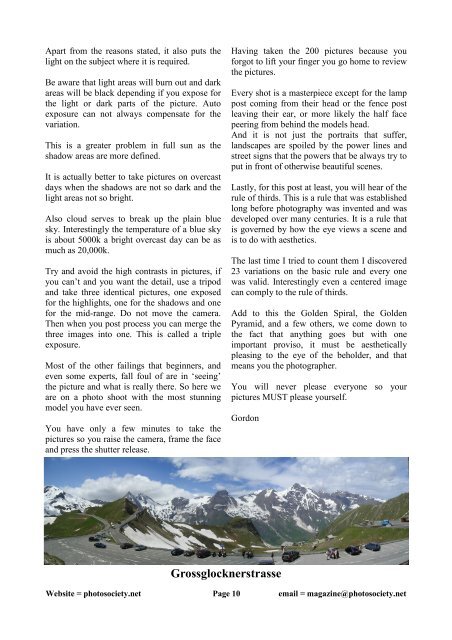World Image issue 11 October 2014
The Journal of the Peoples Photographic Society. Published on the 25th of each month, the latest edition is at: www.photosociety.net
The Journal of the Peoples Photographic Society. Published on the 25th of each month, the latest edition is at: www.photosociety.net
- No tags were found...
You also want an ePaper? Increase the reach of your titles
YUMPU automatically turns print PDFs into web optimized ePapers that Google loves.
Apart from the reasons stated, it also puts the<br />
light on the subject where it is required.<br />
Be aware that light areas will burn out and dark<br />
areas will be black depending if you expose for<br />
the light or dark parts of the picture. Auto<br />
exposure can not always compensate for the<br />
variation.<br />
This is a greater problem in full sun as the<br />
shadow areas are more defined.<br />
It is actually better to take pictures on overcast<br />
days when the shadows are not so dark and the<br />
light areas not so bright.<br />
Also cloud serves to break up the plain blue<br />
sky. Interestingly the temperature of a blue sky<br />
is about 5000k a bright overcast day can be as<br />
much as 20,000k.<br />
Try and avoid the high contrasts in pictures, if<br />
you can’t and you want the detail, use a tripod<br />
and take three identical pictures, one exposed<br />
for the highlights, one for the shadows and one<br />
for the mid-range. Do not move the camera.<br />
Then when you post process you can merge the<br />
three images into one. This is called a triple<br />
exposure.<br />
Most of the other failings that beginners, and<br />
even some experts, fall foul of are in ‘seeing’<br />
the picture and what is really there. So here we<br />
are on a photo shoot with the most stunning<br />
model you have ever seen.<br />
You have only a few minutes to take the<br />
pictures so you raise the camera, frame the face<br />
and press the shutter release.<br />
Having taken the 200 pictures because you<br />
forgot to lift your finger you go home to review<br />
the pictures.<br />
Every shot is a masterpiece except for the lamp<br />
post coming from their head or the fence post<br />
leaving their ear, or more likely the half face<br />
peering from behind the models head.<br />
And it is not just the portraits that suffer,<br />
landscapes are spoiled by the power lines and<br />
street signs that the powers that be always try to<br />
put in front of otherwise beautiful scenes.<br />
Lastly, for this post at least, you will hear of the<br />
rule of thirds. This is a rule that was established<br />
long before photography was invented and was<br />
developed over many centuries. It is a rule that<br />
is governed by how the eye views a scene and<br />
is to do with aesthetics.<br />
The last time I tried to count them I discovered<br />
23 variations on the basic rule and every one<br />
was valid. Interestingly even a centered image<br />
can comply to the rule of thirds.<br />
Add to this the Golden Spiral, the Golden<br />
Pyramid, and a few others, we come down to<br />
the fact that anything goes but with one<br />
important proviso, it must be aesthetically<br />
pleasing to the eye of the beholder, and that<br />
means you the photographer.<br />
You will never please everyone so your<br />
pictures MUST please yourself.<br />
Gordon<br />
Grossglocknerstrasse<br />
Website = photosociety.net Page 10 email = magazine@photosociety.net


















